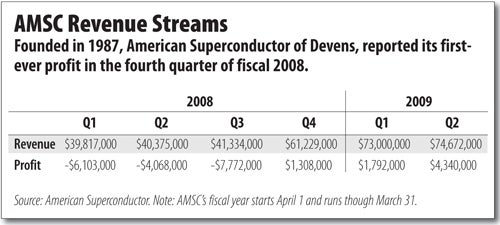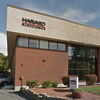Can AMSC Finally Make Its Technology Pay Off?
American Superconductor was founded in 1987 on the basis of the idea that superconducting materials could revolutionize the way electricity is transported. Twenty-two years later, the Devens-based company finally turned a profit for the first time, but only because of revenues from a wind power business that it acquired in the interim.
Now, a new deal to provide the pipelines for a major renewable energy project raises the question of whether the superconductor business can succeed in its own right.
Making Friends
In October, the company announced that its ceramic superconducting fiber will form the basis of a renewable energy hub in New Mexico, known as Tres Amigas. The hub is designed to connect the three power grids that transport electricity around the country, allowing green energy to move from one region to another.
“This is a big national project,” said American Superconductor spokesman Jason Fredette. “It’s a first-of-its-kind kind of system.”
Fredette said the company can’t provide any estimates of what Tres Amigas, which is still negotiating with potential customers and waiting on regulatory approvals, could mean to its bottom line. But he said the environment for the company’s superconductor business has generally warmed up over the past three years.
The change began, Fredette said, with projects in Columbus, Ohio, and Long Island, N.Y., that demonstrate feasibility of using the company’s high-temperature superconductors in regional transmission grids. With those projects up and running, Fredette said, companies can now visit live examples of the technology and see how they work before signing on to try them. He said that’s led not only to the Tres Amigas project but also to the adaptation of American Superconductor technology in projects in China and Korea.
Still, superconductors don’t mean much to the company when it comes to financial results. American Superconductor posted its first-ever profit in the fourth quarter of fiscal 2008, due entirely to its “power systems” business—mostly building components for wind turbines. Its latest quarterly results, for the three months ended Sept. 30, show its revenues from power systems at $71.8 million, compared to $2.9 million for superconductors.
Theodore O’Neil, an analyst who follows American Superconductor for Kaufman Bros. LP, said the company’s value in the stock market is based entirely on the health of its power systems business.
“Since the wind power is 90 percent of their revenue and 100 percent of their profits, I don’t think investors are putting any value on the superconductor side of their business,” he said.
Waiting For The Breakthrough
O’Neill said he’s been following American Superconductor founder Greg Yurek’s efforts since he was working in a “basement laboratory in Watertown.”
“I’ve heard all the potential applications for high-temperature superconductors and haven’t seen any of them pan out,” he said.
But O’Neill said renewable energy may offer the best chance yet for the superconductor business to get out of the red. For one thing, he said, the federal government is likely to offer tax credits for projects like Tres Amigas. And he said superconductors could be a key to making more powerful wind turbines that are small enough to be practical, or to moving environmentally friendly wind power all across the country.
“You can either run a six-lane highway worth of overhead wires, or you can bury something in the ground,” O’Neill said. “Burying something in the ground would be one of these high-temperature cables.”
He said long-distance electrical transmission projects would be most likely to use superconductors in populated areas near the coasts, where huge overhead cable systems would be too ugly for the public to accept.
Fredette agreed that there are many potential uses for the superconductors, though he said the company doesn’t know when they might turn the corner into profitability.
“We’re certainly not in the superconductor business to lose money forever,” he said. “We see signs on the horizon that the business is starting to turn, but it will take some time for that to trickle through our financial results.”











0 Comments